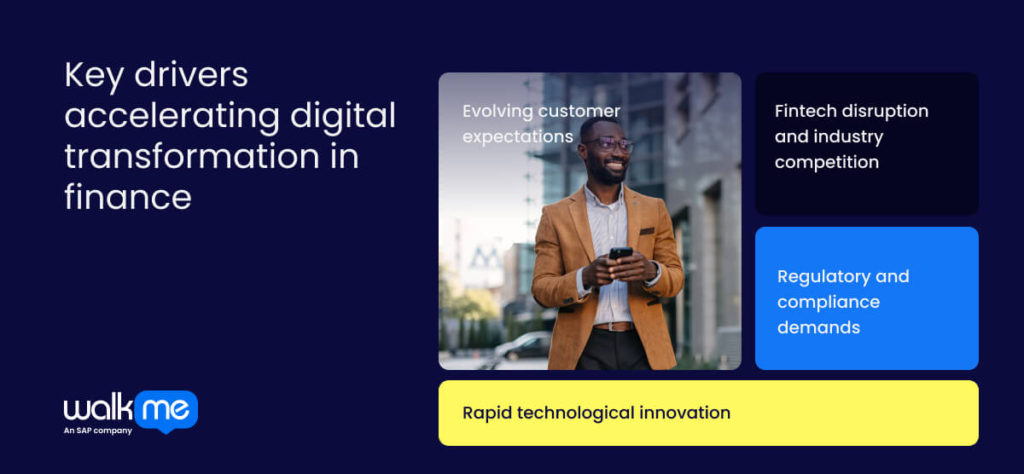Customers want financial services to be as accessible as other online services. To meet these expectations, firms must adopt digital transformation and embrace new technologies. But this requires a strategy and goes beyond upgrading systems.
Finance leaders have a key role in driving this digital transformation strategy. This is because they understand the organization’s finances and manage resources. They can highlight how technology can improve efficiency, employee productivity, and innovation.
This article will explain what digital transformation in finance means, the key drivers, top technologies shaping the industry, real-world examples of companies adopting these changes and future digital trends impacting finance.
What is digital transformation in finance?
Digital transformation in finance involves using digital tools and strategies to enhance operations and deliver personalized customer experiences.
To succeed, financial institutions must eliminate data silos and rethink their service models.
A strong digital transformation strategy should prioritize customer experience by analyzing data, engaging effectively, and understanding customer needs.
Key drivers accelerating digital transformation in finance

The primary drivers of digital transformation in finance are:
Evolving customer expectations
Customers want digital methods to manage their accounts. They seek personalized products, real-time access, transparency, and strong security. Mobile devices and the need to stay connected drive this demand.
To meet these needs, financial businesses must embrace digital transformation. This involves analyzing customer data to understand behavior. Then, you can offer products and services that fit their needs.
Fintech disruption and industry competition
Fintech companies are transforming the financial industry with innovative solutions. Unlike traditional banks, they create new services. They use technologies like blockchain, AI, and peer-to-peer (P2P) lending. This approach challenges existing financial systems and introduces fresh business models.
To stay relevant, traditional banks must embrace digital transformation. Expanding digital services and improving online security are essential steps. A seamless and convenient digital experience is now a key expectation for customers.
Regulatory and compliance demands
Businesses must adopt regulatory technologies (RegTech) to follow the rules on data collection, storage, and use. Laws like GDPR (General Data Protection Regulation) demand strict control over personal data. This pushes companies to use better data management and clear privacy policies.
Rules from the Dodd-Frank Act and Anti-Money Laundering (AML) laws need detailed monitoring and reporting of transactions. This leads companies to use big data analytics and automation tools.
Additionally, cybersecurity rules, like the NIST framework, also compel businesses to strengthen their security. This drives the use of advanced tools to detect and stop cyber threats.
Rapid technological innovation
Faster technology growth creates more chances for businesses to improve how they operate. This drives digital transformation by giving businesses new tools. These include artificial intelligence, cloud computing, and automation.
These tools help companies work better and offer personalized customer experiences. They can also help make better decisions with data and adapt quickly to market changes.
For instance, AI and machine learning help analyze big data, automate tasks, and improve customer service. Cloud computing gives businesses on-demand computing power. This makes it easier to scale and remain agile.
Emerging technologies transforming financial operations
The main types of technologies changing financial operations for the better are:
Artificial intelligence (AI) and machine learning (ML)
AI and ML are being used to transform banking in many ways. They help analyze big data, automate tasks, and improve the user experience.
AI is also used in banking through chatbots to handle basic customer questions. ML helps track changes in user behavior and detect fraud at a quicker rate.
Blockchain technology
Blockchain and cloud solutions are changing finance by enabling secure and clear transactions. Its decentralized design improves safety and transparency. This speeds up processes and reduces fraud.
Cloud computing
Cloud computing lets companies store and analyze financial data in real-time. This provides insights into market trends, customer behavior, and risk. The pay-as-you-go model helps companies save money by only paying for what they use.
Cloud-native systems also back up and replicate data in many locations. This ensures business continuity during outages or disasters. These platforms also offer advanced technologies like AI and machine learning. In this way, financial institutions can create new products and services quickly.
Big data and advanced analytics
Big data is becoming more important in finance. It helps the industry make better decisions, improve customer experiences, and stay competitive. Financial services use big data to collect and analyze information.
They source this information from customer transactions and social media. This helps them spot patterns in customer behavior, target marketing, and prevent fraud.
Real-world examples of digital transformation in finance

To understand how digital transformation in finance works, look at these real-world examples:
Bunq: AI-powered fraud detection in banking
Bunq became the first European bank to make a profit in 2023. They earned 53.2 million euros during that year. It started using AI and machine learning in 2018 to track transactions and prevent money laundering.
For the past two years, Bunq has used Nvidia’s AI platform to detect fraud. This system checks around 520 different things about each payment. This includes the time of the payment, how quickly the information was entered, and the amount of money being sent. This helps them figure out if the transaction is real or not.
UBS: Blockchain for cross-border payments
Sending money across borders can be slow and tricky. But blockchain technology is making it easier. It reduces fraud, cuts costs, and makes payments more transparent. This makes cross-border transactions easier.
Swiss bank UBS is launching a blockchain solution for these payments. UBS Digital Cash runs on a private blockchain for approved clients. You can process payments using smart contracts once it meets all conditions. The tool can record transactions in a digital ledger, no matter the currency.
Close Brothers: Robotic process automation in the end-to-end payouts process
RPA tools, like UiPath, help banks automate tasks that used to be done by hand. This saves time and reduces errors.
Close Brothers used UiPath to automate how they check and process payments. Before, manual work often led to delays and mistakes.
UiPath can read documents and automatically ask for any missing information. Once complete, the team reviews the information. This allows the team to focus on more important tasks.
Close Brothers is now using UiPath in other areas of their business. For example, they help companies that rent equipment to their customers. UiPath helps speed up payments to these companies.
Monzo: Digital-only banking platforms
Digital-only banks let you bank easily using your smartphone. They often charge lower fees and offer better interest rates than regular banks. You can manage your money from anywhere with an internet connection.
Monzo is a popular digital bank. Their app has helpful features like tools to track your spending and set budget alerts. They also offer useful information, such as a calculator to help you pay off your mortgage faster.
Last year, Monzo made a profit of $19.5 million. They plan to expand their services to Europe, starting with an office in Dublin. They will also introduce a new pension product this year and plan to offer more mortgage options.
Worldline: Payment solutions and embedded finance
Embedded finance lets non-financial companies offer financial services like loans, insurance, and payments. They do this by partnering with other companies that specialize in these services. This way, they don’t have to build their own financial systems or deal with complex regulations.
Through this service, customers can access everything in one place. For example, Worldline and OPP launched an embedded payments solution in Europe. It combines Worldline’s payment processing with OPP’s technology.
This allows platforms to offer features like split payments and escrow services. Any non-financial business that adopts this solution in the future will allow users to sell services and get paid in various currencies.
Digital transformation trends shaping the finance industry
Digital transformation shapes the financial industry’s future in the following ways:
Real-time financial reporting
Digital transformation will allow real-time rather than periodic finance reporting in the future. It automates data collection through enterprise resource planning cloud solutions. This allows businesses to access real-time financial data. In this way, leaders can make quicker decisions based on up-to-date information.
Additionally, they can respond faster to market changes and challenges. Real-time monitoring also helps spot issues early, preventing costly mistakes.
Decentralized finance (DeFi) growth
DeFi is an open financial system based on blockchain technology. It allows people to access financial services like banking without going through traditional banks. These services are secure and transparent.
More and more people are interested in DeFi because it offers faster and cheaper financial solutions. Experts predict the global DeFi market could grow to be worth over 600 billion dollars by 2033. DeFi can also help people who don’t have bank accounts and make it easier to send money across borders.
Additionally, it supports new and innovative financial products and makes financial transactions more transparent. Technology plays a crucial role in the growth of DeFi. Improvements in blockchain technology, like better scalability, smart contracts, and strong security measures, will help DeFi reach more people.
Rise of self-service financial tools
Digital transformation in finance will increase the use of self-service tools. These tools allow customers to transfer money and access account details online. So, financial services will continue to be more convenient and accessible.
Next, data analytics will personalize services based on each customer’s financial needs. Customers will use AI chatbots to answer questions and solve simple issues.
Gig economy integration into finance models
Although gig economy work is flexible, it brings financial challenges. Workers often face unstable income, limited banking options, and complicated taxes. Digital transformation can help financial services create tools for gig economy workers.
For instance, it can support gig workers by offering tools like automatic expense tracking to manage their earnings. This tool could also include invoicing and real-time income updates. It can also help create tax tools to help gig workers calculate and manage their taxes.
Adapting to new landscapes in finance
The financial industry is under constant pressure to improve. They need to fix problems like slow systems and too much paperwork.
To succeed, they’ll use new technologies like blockchain, cloud computing, and artificial intelligence. These tools will help them offer better services and find new ways to do business.
As companies move online, financial leaders must become more strategic. They need to lead innovation and help their companies adapt to change.
They should also focus on sustainable growth. This means creating financial products that are good for the environment and society. These strategies help companies make money while also being responsible.
But, there are challenges like a lack of skilled workers and resistance to change. Overcoming these challenges is crucial for a successful digital transformation.
FAQs
Digital technology can be used in finance to automate mundane tasks, analyze customer data, simplify payment processes, or improve customer interactions.

